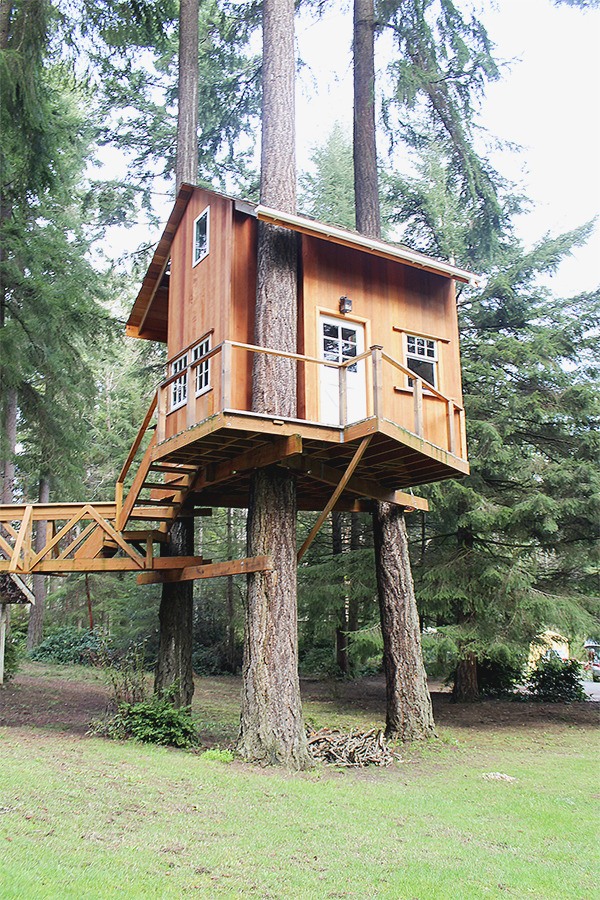It started out innocently enough. After a day of playing in the snow at Snoqualmie a few winters back, my partner Richard Parr and I stopped for a quick turn through the gift shop at the Salish Lodge to find presents for some far-away family members. Little did I know when I picked up Pete Nelson’s “Treehouses of the World” book and said “Hey hon, have you seen this?” that I had planted a seed that would grow into the mother of all DIY projects.
Richard is a project person. Never really content unless he’s doing something, he likes to be busy. He also loves a challenge. Invoking the spirit of British mountaineer George Mallory and his famous “Because it’s there” explanation of why he wanted to climb Mount Everest, after reading Nelson’s book, Richard declared that he was going to build a treehouse.
“Mostly just to see if I could,” he’ll say. Not to mention the fact that treehouses are pretty cool.
But it was also to have a quiet, retreat-type of space. Not necessarily a “man cave,” but ultimately similar in its intended use.
Never in my wildest dreams did I imagine that when we were later looking for a house to buy on Vashon, one of our criteria would be that there had to be the “right” trees on the property for a treehouse. And yet there we were, at every house we viewed, me looking at kitchens and bathrooms and Richard outside looking at the trees.
Eventually we found just the right spot, and within a few months of moving in, the project was underway.
After picking the best and healthiest grouping of trees — a stand of three 100-foot-plus Douglas firs in the middle of our property — Richard came up with the design. The 196-square-foot structure would have a main living area with enough room for a window seat, desk and seating in front of a TV, as well as a loft space big enough for a bed. He would build a bridge to the treehouse that spanned another set of nearby trees and led to a staircase to the front door.
With his construction experience limited to one house renovation, building from scratch in the trees and 20 feet off the ground, was foreign territory for Richard. But after extensive research and reading on the subject, he felt he was ready. He also obtained the right support hardware from Michael Garnier, a pioneer of modern treehouse construction and creator of the Garnier Limb, a specialized support bolt with hardware designed to move with the trees.
With plans that existed only in his head and using cedar for its looks, light weight and pest resistance, the project took close to a year to complete. Richard did everything by hand, from measuring and cutting every piece of wood, nailing every board, insulating and wrapping, to roofing and staining. Help and advice was provided on occasion by various people, including local rowers whom Richard coaches, some of whom are architects, engineers and home builders. Our oldest son, myself and even the junior rowers often got in on the action when more than two hands were needed. While there is no plumbing in the treehouse, there is electricity and even cable. (Electricians were called in to do the wiring and install the lights, and Comcast noted that it wasn’t often, or ever, that their technicians wired treehouses for cable.)
We found windows and a Dutch door at Second Use and Earthwise, architectural salvage stores in Seattle. The interior has an eclectic mix of furnishings — a desk is from the old Vashon High School; a recliner and ottoman belonged to my mother, who passed away unexpectedly the fall that the project began; the slate around the wood stove was from old McMurray Middle School chalkboards, and artwork on the walls includes a painting by Richard’s father, who died in 2011, and a hand-carved piece by Native American artist David Boxely that I found at Raven’s Nest.
Overall, we’ve enjoyed the results very much. We’ve had friends over to watch Seahawks games in the treehouse, spent time reading, had quiet dinners and even slept in it.
For his part, Richard is satisfied with the endeavor and often remarks that it’s hard to believe he really built it.
“The hardest part was putting the upper timber-frame beams in place,” Richard says, and while he was harnessed for safety during the majority of the build, starting the low edge of the roofing caused the most anxiety — for me.
Aside from providing the proof that he could, in fact, build one, our little house in the trees is exactly the space Richard was hoping for.
“It’s got a warm quietness to it,” he said. “It makes a very peaceful retreat.”



